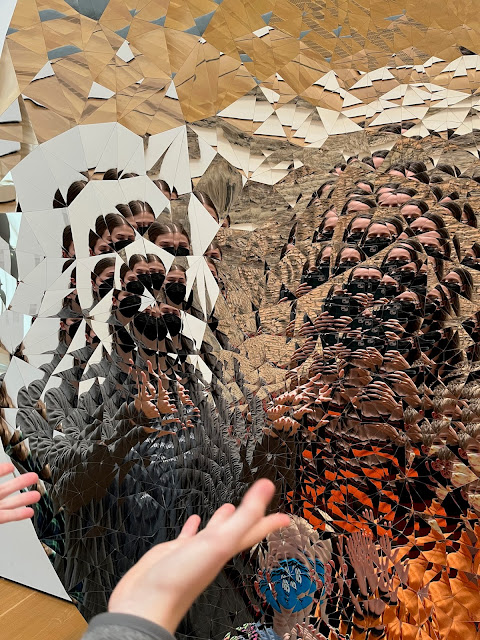Sensing my "hey-you-just-went-to-a-fancy-art-museum-in-Chicago-and-I-am-getting-thrown-up-on-over-here" fomo vibes, Andrew and I coordinated to purchase a pass to the High Museum of Art while he was out of town (with six children, the family pass seems very affordable). Today we all went to the museum together.
We started at the top of the museum—African and Folk Art—and worked our way down. Here are some of our crew admiring the truly amazing masks on display:
I'm sure they were trying to imagine balancing while wearing that very tall mask (I know I was).
Folk art is always intriguing to me—the idea that someone without any training just wakes up one day and decides to be an artist (which is a fair decision to make, because why not?). I just feel like there is sometimes some gatekeeping that goes on around art, as if you can only create if you are trained, that you're only an artist if people immediately appreciate your work. I see that sometimes in academia, with my work and research in poetry—as if your poetry is only good and valid if others view it as good and valid, and it passes this test if it is "published." But, like, Emily Dickinson was largely unpublished. So I think someone can be a real writer, a real artist, a real whatever, even if they just quietly create in their own backyard, filling their home (Nellie Mae Rowe) and/or yard (Howard Finster) with art.
Finster's ambitions reminded me very much of Thomas Battersby Child's Gilgal Gardens in Salt Lake. We'll have to stop by Paradise Gardens sometime (it looks like it might be "on the way" to Chickamauga, so if we ever head up that way again, I guess). Here's a smattering of Finster's work:
Dear Friend,
Would you like to go to the High Museum of Art in Atlanta with me? I have three exhibits in mind that would be interesting to go to. The first one is Monir Farmanfarmaian’s A Mirror Garden (“Monir Farmanfarmaian”). It consists of multiple geometric mirror sculptures, little-seen drawings, and collages she made. Monir Farmanfarmaian was an Iranian artist, and many of her designs mimic the style of Islamic and Iranian architecture, such as Muqurnas, which she created when she was 90 years old. It imitates the honeycomb vaulting found in lots of mosques around the world, is made out of mirrors, and is incredibly intricate. She used a seventeenth-century decorative technique called ayeneh-kari, or mirror work.
When we told the kids we were going to the museum, Miriam quickly went online to see if Farmanfarmaian's collection was still on exhibit and...we'd unfortunately missed that window...which she was disappointed about because she really had been intrigued by Farmanfarmaian's sculptures.
So she was delighted when we rounded the corner and were met by light dancing off of Muqarnas. Here she is admiring it:
Rachel with a billion Grandpas in the background:
Here's everyone talking about it:
The paintings you are referring to are the Joseph Smith series. Joseph Smith was the father of the Mormon Church. Mormonism is a modern religion, and these paintings are about modernist strategy. In their stiffness and gestural quality, they present Joseph Smith in a frozen fascistic pose. If you take the gloves and hats and socks off the dowels, you remove the image of the figure, leaving a process-oriented abstract painting. The brush-limbs are attached to the pieces of the frame. The dowels that the gloves, socks, and hat are attached to are part of the frame, and they push large amounts of paint into the center of the canvas, which forms the body of Joseph Smith. Instead of the perimeter of the canvas defining the limits of the painting, as in current modernist series, some of the frame helps paint the painting itself, therefore having a dual role as a brush and boundary.
Here's Phoebe walking down the ramp with her brothers (she insisted on holding both their hands):
And here's the big piece in the center of the building (that I didn't go read the sign for, sorry artist):
Here's Benjamin admiring some pieces by Hale Woodruff:
And here's Rachel taking in some Monet:

Here's Rachel adding a creation to the art tree:
Here's Andrew after a failed attempt at leaning against what he thought was a pillar and was actually a foam tower Benjamin was building:
Here's Benjamin saying, "Bro, what?"
And here's Andrew knocking the tower over the rest of the way:











.jpeg)


















No comments:
Post a Comment